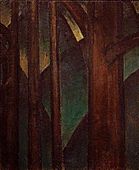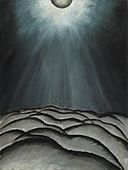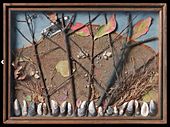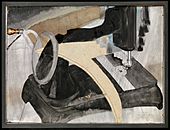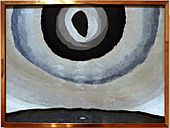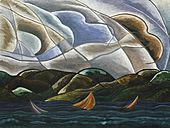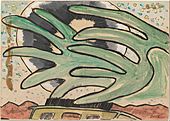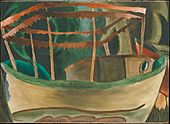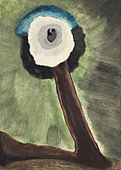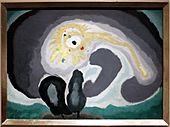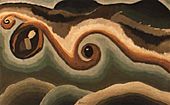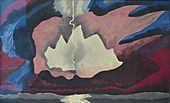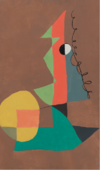Arthur Dove facts for kids
Quick facts for kids
Arthur Garfield Dove
|
|
|---|---|
 |
|
| Born | August 2, 1880 |
| Died | November 23, 1946 (aged 66) |
| Known for | Modernism, abstract art |
Arthur Garfield Dove (born August 2, 1880 – died November 23, 1946) was an American artist. He was one of the first American artists to create modern art. Many people think he was the first American painter to create abstract art. Abstract art uses shapes, colors, and forms instead of showing things exactly as they look.
Dove used many different materials in his art. Sometimes he mixed them in new ways. He made abstract paintings of landscapes and other subjects. For example, his painting Me and the Moon from 1937 is a famous abstract landscape. In the 1920s, Dove also made experimental collages. He even tried mixing paints like oil or tempera with wax. His 1938 painting Tanks shows this technique.
Contents
Early Life and School

Arthur Dove grew up in a rich family in Canandaigua, New York. His parents, William George and Anna Elizabeth, were from England. His father, William Dove, was interested in politics. He named his son Arthur Garfield after two Republican politicians, James Garfield and Chester Arthur. They were running for president and vice-president in the 1880 election and won.
Arthur loved being outdoors on the family farm. His father was a successful businessman who owned a brickyard. He wanted Arthur to become wealthy too. As a child, Arthur enjoyed playing the piano and taking painting lessons. He also played baseball in high school. A neighbor named Newton Weatherby became his friend. Newton was a naturalist who took Arthur on hunting, fishing, and camping trips. These trips helped Arthur love nature even more. Weatherby was also an amateur painter and gave Arthur leftover canvas to paint on.
Dove went to Hobart College and Cornell University. At Cornell, he took art classes. He finished college in 1903. Arthur was chosen to draw pictures for the Cornell University yearbook. His drawings were popular because they made the people and situations seem real. After college, he became a well-known artist for magazines like Harper's Magazine and The Saturday Evening Post in New York City. Arthur's parents were not happy that he chose to be an artist. They wanted him to choose a job that would make more money.
Time in Europe

In 1907, Dove and his first wife, Florence, traveled to France. They moved to Paris, which was the art capital of the world back then. They also took short trips to Italy and Spain. In Paris, Dove joined a group of artists from the United States. One of them was Alfred Henry Maurer, who became a good friend.
While in Europe, Dove learned about new painting styles. He was especially interested in the Fauvist art of Henri Matisse. Fauvism used bright, strong colors. Dove showed his art at the yearly Autumn Salon in 1908 and 1909. He felt more confident as an artist after this. When he returned to New York, he was not happy working as a commercial artist anymore. So, Dove moved out of New York City. He decided to make a living by farming and fishing. This way, he could spend more time painting. His son, William C. Dove, was born on July 4, 1909.
Working with Alfred Stieglitz
When Dove came back to America in 1909, he met Alfred Stieglitz. Stieglitz was a famous photographer and owned an art gallery. He was very important in bringing modern art to America. He showed art by European artists that Americans had never seen before. Dove wanted to stop being an illustrator. He needed help finding his artistic style and feeling more confident. Stieglitz helped him with both.
Stieglitz was 16 years older than Dove. They came from different backgrounds, but they both believed that art should show modern spiritual ideas, not just old traditions. With Stieglitz's help, Dove created what are thought to be the first truly abstract paintings by an American. Dove's art was based on things he saw in nature. He called his style "extraction." This meant he took out the main shapes and forms from a scene in nature.
Dove showed his art at Stieglitz's 291 gallery in 1910. The show was called "Younger American Painters." Dove showed one painting, a large still life called “The Lobster.” This was his last painting that showed things exactly as they looked. In 1912, Stieglitz gave Dove his first solo show at the 291 gallery. This show included a group of Dove's pastel drawings called "The Ten Commandments." It was the first time abstract art by an American was shown to the public.
After meeting Stieglitz, Dove became a leader in modern art. From 1912 to 1946, Dove showed his art every year at Stieglitz's galleries. These included 291, Intimate Gallery, and An American Place. Dove used many different materials in his art. In the 1920s, he made many works on paper, like Nature Symbolized (or Reefs) from 1924. He also made experimental collages like The Critic (1925) and The Intellectual (1925). He tried new ways of painting, like using oil or tempera paint over a wax base. Tanks (1938) is an example of oil over a wax base. The Boston Museum of Fine Arts says that in Tanks, the shapes seem to almost disappear into the background, but they still look strong.
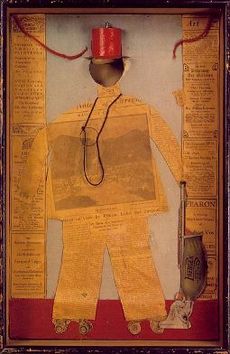
Support from Duncan Phillips
Even with support from other artists, Dove often had to earn money by farming, fishing, or drawing for magazines. His most loyal supporter was Duncan Phillips. Phillips started the Phillips Collection art museum in Washington, D.C. This museum now has most of Dove's artwork. Dove's art helped Phillips understand that abstract art was a true artistic process, not just a style.
Phillips first visited Stieglitz's gallery because of Dove's art. He kept coming back to see more of Dove's work. Phillips paid Dove $50 a month. In return, he got to choose the first paintings from each new exhibition. Dove and Phillips only met once, in 1936. In 1937, Phillips bought Dove's painting Goin Fishin for $2,000. This was the most money ever paid for one of Dove's works at that time. Phillips also bought “Huntington Harbor 1.” Between 1924 and 1930, Dove made about twenty-five assemblages, which are artworks made from different objects.
Arthur Dove and Helen Torr
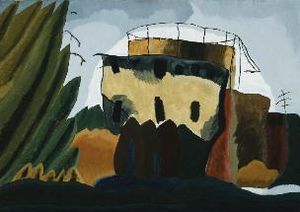
Dove lived for seven years on a houseboat called Mona with Helen Torr. She was called "Reds" because of her bright red hair. Helen Torr was also a painter. Dove's first wife, Florence, was not interested in his art. After 25 years of marriage, Dove left Florence. She would not divorce him and would not let him see their son. When he left, he took almost nothing with him except some art magazines and letters from Stieglitz.
When Florence died unexpectedly, Dove paid for her funeral. He sent flowers but did not go to the funeral. He was sad about her death, but now he could see his son and marry Helen Torr. After eight years, Dove met his son, Bill, who was 19 years old and also an artist. They became friends. Later, Bill helped Dove create a special way to make silver frames for his art.
Dove and Torr could not get married right away because Helen was not divorced from her first husband. They finally married in April 1932 at New York City Hall. It was a short ceremony, and they used a cheap ring. On his marriage paper, Dove wrote that his job was "frame maker." In 1933, Stieglitz allowed Torr and Dove to show their art together for the only time. This show, called "Seven Americans," brought Dove back into the news. His art influenced later abstract landscape painters, like Julian Hatton and Georgia O'Keeffe. They were inspired by his "love of pure, hot color."
Arthur Dove-Helen Torr Cottage
|
Arthur Dove-Helen Torr Cottage
|
|

The Dove-Torr Cottage from across Centershore Road in November 2017
|
|
| Location | 30 Centershore Rd., Centerport, New York |
|---|---|
| Area | less than one acre |
| Built | 1938 |
| Architectural style | Late Victorian |
| NRHP reference No. | 99001682 |
| Added to NRHP | January 28, 2000 |
In July 1924, Arthur Dove and Helen Torr sailed into Huntington Harbor on their boat, Mona. They probably didn't know how much the North Shore of Long Island would inspire their art. They lived in Halesite until the Great Depression. Then, Dove and Torr moved back to Dove's family home in Geneva.
In 1938, the couple wanted to return to Long Island. They moved back into their first home there, which used to be a post office and general store. It was on Center Shore Road in Centerport, New York. They bought the house for $980. The small, one-room cottage was next to the Titus Mill Pond. Soon after moving, Dove got pneumonia. He later had a heart attack and was diagnosed with a serious kidney disorder.
He was very sick for the rest of his life. But he lived quietly and could finally spend all his time painting. He found inspiration in his surroundings and his home. Some of his most powerful paintings, like Indian Summer, were made in Centerport. Helen Torr stayed in the house after Dove's death but never painted again. Helen Torr died in 1967. In 1979, her artworks and Dove's were shown together at the Museum of Modern Art in New York.
The Arthur Dove-Helen Torr Cottage was added to the National Register of Historic Places in 2000. This means it is a special historic place.
Later Life and Legacy
Dove suffered from heart disease and kidney problems in the late 1930s. He had a heart attack in 1939 and never fully recovered. In 1946, Dove had his last art show with nine new paintings. He made his final visit to the gallery and saw Stieglitz for the last time. In July of that year, his first grandchild, Toni, was born.
A little over a month after his show closed, Stieglitz died. Dove was very sad about his friend's death. He lived for only four more months. Even though he became partly paralyzed by a stroke, he kept painting with Helen Torr's help. She guided his brush. He painted until he collapsed and died at Huntington Hospital. Arthur Dove died on November 23, 1946, after another heart attack and kidney failure. He was buried at the Memorial Cemetery of St. John's Church in Cold Spring Harbor, New York.
Just before he died, Dove wrote to Duncan Phillips for the last time. He thanked Phillips for his support. He said Phillips's help saved his art and meant so much to him. He also mentioned Stieglitz's amazing ability to see new ideas in his paintings. Arthur Dove's granddaughter is the interactive artist Toni Dove.
In 2017, the city of Geneva, New York, received money to help fix up the 1878 Dove Block building. This building was once Dove's art studio in the 1930s.
Selected Works
Images for kids
See Also
 In Spanish: Arthur Garfield Dove para niños
In Spanish: Arthur Garfield Dove para niños






